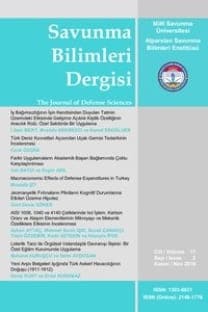Uluslararası Çatışmaların Değişen Yapısında Terörün Yeri ve Önemi Üzerine Bir İnceleme
Terör, Terörist, Gerilla, Terörle Mücadele, Güvenlik
A Research on the Place and Importance of the Terror in the Changing Structure of International Conflicts
Terror, Terrorist, Guerilla, War Againts Terrorism, Security,
___
- Kitaplar
- Berkowitz, Leonard. (1962), Aggression: A Social Psychological Analysis. New York: Mcgraw Hill. Berner, Brad K. The World According to Al Qaeda. New Delhi: Peacock Books, 2007. Crenshaw, Martha (1998), Theories of Terrorism: Instrumental and organizational approaches, Inside Terrorist Organizations, ed. David C. Rapoport New York: Colombia University Press, s.16. Crenshaw, Martha (2011), Explaining Terrorism: Causes, Processes and Consequences, Oxford: Routledge. Gökçe, Orhan, Uğur Demiray (2004), Medya Terör İlişkisi ya da İklemi. Terörün Görüntüleri, Görüntülerin Terörü. ed. Orhan Gökçe, Uğur Demiray. Konya: Çizgi Kitabevi, s. 3. Gurr, Ted Robert (1970), Why Men Rebel. Princeton, NJ: Princeton University Press. Hardman, J. B. S. (1936), Terrorism, Encyclopedia of Social Sciences. c. 14. New York: Macmillan Publishing, s. 575-576. Paret, Peter (1964), French revolutionary warfare from Indochina to Algeria. London: Pall Mall Press. Merari, Ariel (2016), Ayaklanma Stratejisi Olarak Terörizm. Terörizmin Tarihi, ed. Arnaud Blin, Gerard Chaliand. İstanbul: Nora Kitap, s. 25. Rapoport, D. C. (2013). The four waves of modern terror: International dimensions and consequences. ed. J. M. Hanhimäki & B. Blumenau An international history of terrorism: Western and non-Western experiences London: Routledge. ss. 282–311. Richardson, Louise (2006), What Terrorists Want: Understanding the Enemy, Containing the Threat, New York: Random House Publishing. Thayer, Charles W. (1965), Guerrilla, New York: Signet Books. Thorton, Thomas P. (1964), Terror as a Weapon of Political Agitation, Internal War: Problems and Approaches. ed. Harry Eckstein. New York: Free Press, s. 73. Tılısbık, Niyazi, Özdemir Akbal (2006), İstihbarat ve Türkiye, Konya: Nüve Kültür Merkezi Yayınevi. Waciorski, Jerzy (1939), Le Terrorisme Politique, Paris: A. Pedone.
- Makaleler
- Abrahms, Max. (2008), What Terrorists Really Want: Terrorist Motives and Counterterrorism Strategy. International Security. c. 32. s. 4 s.78. Greenberg, Jeff, Jamie Arndt (2012), Terror Management Theory, Handbook of Theories of Social Psychology: Volume 1. ed. Paul A. M. Van Lange, Arie W. Kruglanski, E. Tory Higgins. London: Sage Publications, s. 399. Kalay, Güler (2014), Terör ve Terörizm. Politika Dergisi. s. 14. McCormick, Gordon. “Terrorist Decision Making”. Annual Review of Political Science. c. 6. (2003): s. 482. Merari, Ariel (1999), Terrorism as a strategy of struggle: Past and future, Terrorism and Political Violence. c. 11. sayı. 4, ss. 52-65. Rubin, Barry, Judith Colp Rubin (2002), Anti-American Terrorism and the Middle East, New York: Oxford University Press. Simon, Linda, Eddie Harmon-Jones, Jamie Arndt, Jeff Greenberg, Sheldon Solomon, Teresa Abend, Tom Pyszczynski (1997), Terror Management and Cognitive-Experiential Self-Theory: Evidence That Terror Management Occurs in the Experiential System, Journal of Personality and Social Psychology. c. 72. s. 5 s. 1132. Tilly, Charles (2005), Terror as Strategy and Relational Process, International Journal of Comparative Sociology, c. 46. s. 1-2, s.11.
- Web Siteleri
- ABC News, “Chechen Guerilla Leader Calls Russians ‘Terrorists’”, https://abcnews.go.com/Nightline/International/story?id=990187&page=1 (Erişim Tarihi: 17.05.2018).
- ISSN: 1303-6831
- Yayın Aralığı: 2
- Başlangıç: 2002
- Yayıncı: Milli Savunma Üniversitesi Alparslan Savunma Bilimleri ve Millî Güvenlik Enstitüsü
Uluslararası Çatışmaların Değişen Yapısında Terörün Yeri ve Önemi Üzerine Bir İnceleme
Savunma Sanayisinde Aşırı Koşullara Maruz Kalan Hafif Yapısal Malzemelerin Yüzey Modifikasyonu
Hayrani ULUTÜRK, Uğur MALAYOĞLU, Kadir Cihan TEKİN
Rol Belirsizliğinin İş Tatmini ve İşten Ayrılma Üzerindeki Etkisi
Ali GÜRSOY, Kemal KÖKSAL, Hakan YAPAR
Stokastik Talepli Araç Rotalama Problemi İçin Literatür Taraması
Beste DESTİCİOĞLU, Bahar ÖZYÖRÜK
Biyomedikal Uygulamalar İçin TiN Kaplı Ti6Al4V Alaşımının Mekanik Özelliklerinin Araştırılması
